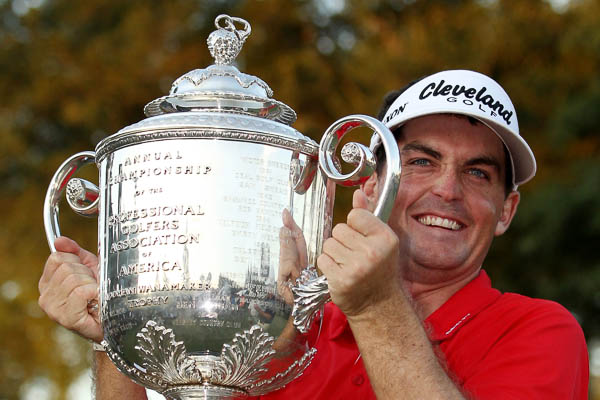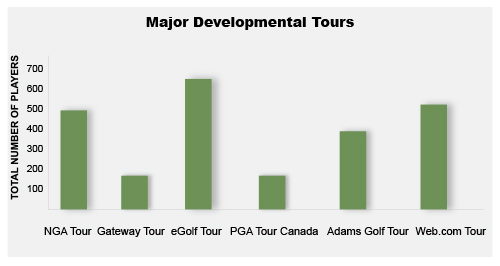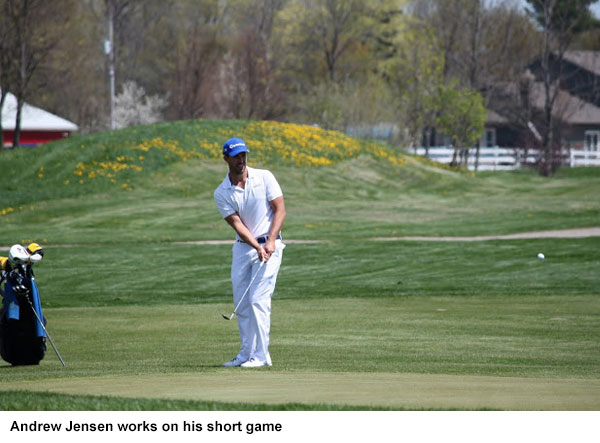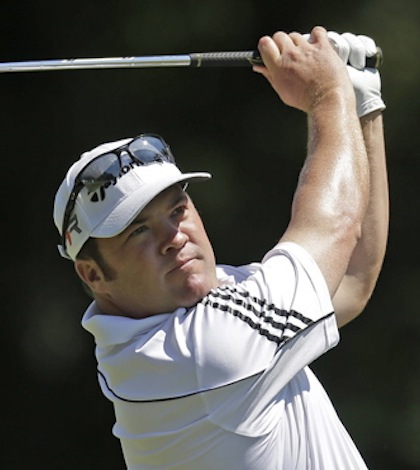Opinion & Analysis
The harsh realities of golf’s mini tours

A casual golf fan who occasionally enjoys watching final round coverage of a PGA Tour event must have a skewed opinion about the lives of professional golfers, namely, that anyone with an oversized staff bag is living the dream. But for every Ian Poulter who owns a fleet of Ferraris and struts around like a movie star, there are plenty of golfers who practically live out of their Ford Fiestas and dream about getting their big break.
Golf outside the highest professional level is a proverbial cutting room floor. For every golfer who eventually plays his way to the big stage, there are thousands who don’t. It’s a harsh reality predetermined by the sheer fact that it takes a high degree of skill, stubbornness and certainly not least of all – luck – to earn a place on the PGA Tour.
The qualification process has remained largely unchanged since the PGA Tour was formalized in the 1960s. The most direct route, Q-School, allowed any golfer, amateur or professional with a handicap index of two or lower, to test their mettle in golf’s version of the Hunger Games. Anyone who didn’t survive Q-School could attempt to play his way onto the Tour by way of Monday qualifiers or sponsor exemptions, both of which are low percentage gambles that very few ever cash in on.
What has changed in the last couple of decades is the ever-expanding number of developmental tours that have raised their banners across the country. Although Ben Hogan isn’t officially credited with starting the first mini tour, the 30-city Hogan Tour, which began in 1990, is probably the most famous. The tour was set up to allow aspiring pros (many of whom were cash-strapped) to drive around from tour stop to tour stop in successive weeks, much like Hogan’s contemporaries had in golf’s yesteryears. Over the years the Hogan Tour (now the Web.com Tour) expanded geographically, upped its prize money and became to the PGA Tour what off-broadway is to aspiring actors.
The NGA Pro Golf Tour, more commonly referred to as the Hooters Tour, predates the Hogan Tour. It was started in 1988 by Rick (T.C.) Jordan who inherited some money from his family’s business in pharmaceuticals and made a lot more of it through real estate and restaurant opportunities. Jordan invested $6 million from his own pocket and ran the tour independently until ceding title sponsorship rights to Hooters of America, Inc. in 1994.
Over the years the Hooters Tour has graduated some notable alumni including major championship winners Bubba Watson, Keegan Bradley, John Daly and Zach Johnson.

Keegan Bradley, a graduate of the NGA Hooters Tour, won the 2011 PGA Championship and is one of the Tour’s best success stories.
And now that the Q-School has been revised to replenish the roster of the Web.com Tour, expect more players to take up a path of apprenticeship that could meander through the Pepsi Tour, over to the Peach State Professional Golf Tour, and everything in-between. With more than 60 tours in operation world-wide, the prevailing wisdom ought to be play hard and pack light.
So You Want To Run A Mini Tour?
Jeff Flees used to manage a mortgage firm in Worthington, Ohio. But his wife’s protracted health concerns led him to reevaluate his career prospects. Nowadays, he’s the president of a three-person operation that runs the nascent Flagship Golf Tour.
“I had a successful career in the mortgage banking industry for 16 years, however in 2011 my wife had two major surgeries, one of which was brain surgery to clip aneurysms she had been living with,” says Flees. “My wife is one of the most incredible, inspirational people you will ever meet or know. I felt it was important to take time off to be with her while she recovered. When the time was right, my passion for golf and experience with people in the industry led my to analyze the developmental tour business and start the Flagship Golf Tour.”
The first scheduled event will be played this summer at The Journey at Pechanga in Temecula, Calif. The single day, 18-hole stroke play championship will feature a $5,000 purse and will benefit a number of charities including the Brain Aneurysm Foundation. The entry fee for professionals is $300 ($200 for amateurs) and unlike many higher profile tours, there is no annual membership fee.
For those of us who have never played golf for a living, taking up membership on a mini tour is a significant expense when combined with standard tournament fees and general travel expenses. Existing tours with deep fields and decent purses can charge $1,000 or more for membership. That will help you get a bona fide member packet, a tour hat and access to practice facilities at host courses. To actually play in a tournament event, you’ll likely drop close to another $1,000. A single season on the NGA Hooters’ 2013 Carolina Series will run a pro golfer a little over $10,000 in fees (depending on whether or not they have pre-existing status on the tour). Sounds almost reasonable until you start factoring things like groceries and gas money, or taking a date out to a dinner and a movie.
By contrast, there’s next to no risk to play a Flagship Golf Tour event and the tour awards prize money to the top 33 percent of the field, which is consistent with the policy maintained by more established entities. The tour does differ significantly from many competitors in that tournament events are spread out nationally and a champion is crowned after 18 holes.
“We decided on the one-day 18-hole tournaments because they make more logistical and financial sense,” says Flees. “The benefit of a one-day, 18-hole event is that we can keep the expenses down and reduce the time commitment for everyone involved in the tournament. We respect what the more established tours are doing. We are not trying to directly compete with them.”
Whether the Flagship Golf Tour finds its niche and succeeds beyond the first couple of seasons is difficult to predict. The term “boom and bust” is often used to describe mini tours that have disappeared after some initial success. Not surprisingly, the pressure to succeed falls squarely on a busy owner’s shoulders. You’re expected to be equally adept at playing the role of savvy business manager and gregarious promoter. Some days call for negotiating contracts with vendors and sponsors. Other days you’ll be rubbing elbows with potential investors or stumping on behalf of your tour around the clock on Twitter.
For many business executives, running a mini tour is a labor of love (not to mention an expensive hobby).
Alex Spanos had a brief run lending his name to one of the preeminent developmental tours on the West Coast before scuttling the business after three years. Spanos was a scratch golfer in his youth and made his fortune in the construction services industry. He is better known for owning a majority stake in the San Diego Chargers football team.
Full field events on the Spanos California Tour featured sizable purses including a $250,000 cash grab called the A.G. Spanos California Open. Local boys Jason Gore, John Merrick and Peter Tomasulo had stints on the tour before moving on to play much bigger venues.
“I have always wanted to be part of a golf tour,” Spanos was quoted as saying. “My goal with this tour is to have it become the biggest and best in this state, if not the country, where young professionals and amateurs get the opportunity to show their talent and ability.”
Even in its final year of operation, the California Tour was arguably still growing. The tour signed Ameriquest Mortgage Company as a presenting sponsor, hired a San Diego area public relations firm to raise brand awareness, increased the number of events to 16 and set aside $2.5 million in available winnings. But they shut the tour down anyway. Perhaps that was the intention all along.
According to executives associated with Spanos, running the tour had become prohibitively expensive. It also didn’t help that a far more expansive developmental tour made a glitzy splash in 2006, promising tournament winnings to rival the PGA Tour.
Backed by the now defunct Greens Worldwide Inc., the U.S. Pro Golf Tour was expected to offer $300,000 for a standard event and as much as $5 million for one of its majors that would be played on a Donald Trump-owed course and broadcast on television by ESPN. There were rumblings about impending doom from the start and the tour folded after the initial season. In the process, the U.S. Pro Golf Tour defrauded hundreds of golfers who forked over thousands of dollars to participate in events that were never going to be staged.
As any professional golfer who has scrambled on the mini tours can tell you, there are plenty of similar misadventures that players have fallen victim to. Most of them are simply too obscure to grab the public’s attention, even within golfing circles. And in some ways, it’s a perverse right of passage.
The (Not So) Charmed Life Of A Professional Golfer
More than likely, you haven’t heard of Andrew Jensen. He’s just another golfer playing on the PGA Tour of Canada who’s had scrapes with success, failure, injuries and heartbreak. But I’m getting ahead of myself.
We pick up his story in March. Jensen has driven down to Florida, as far south from frigid Ottawa as his Pontiac G6 will take him. He intends to spend a month living in the Sarasota area getting into shape for a season that will play out primarily back in Canada. Except that the weather in Florida, in fact for much of the southern United States, isn’t living up to expectations.
Too many mornings in the Sunshine State start off borderline freezing; as for Jensen’s game, it’s not a whole lot better. In his first competitive event of the season, he shoots 2-over and misses the cut. Over the next several weeks his game starts trending in the right direction. He records his best finish on the Florida swing at TPC Prestancia in Sarasota. It’s a limited-field event of 28 participants playing for a purse that barely covers rent for a single-bedroom apartment on Manhattan’s Upper West Side.
Jensen has an opportunity to finish 2-under on the first day, but rinses two balls on the last hole for an ugly double. He plays marginally worse the next day, making three straight bogies on the front nine, carding a 75 and finishing three strokes outside of earning a paycheck.
Three events come and go and all Jensen has to show for it some middling scores. It’s a good blow to one’s wallet (and psyche), but Jensen has developed some thick skin over the years. He’s been playing professionally off and on since 2008. He’s taken time off to heal from injuries and to recover from periodic episodes of depression. And while it may be difficult to spin positives from his Florida swing based on scoring alone, Jensen is grateful to be playing golf regularly again.
“When I was playing injured in 2010 and playing bad . . . the debt was increasing fast,” says Jensen. “Golf was no longer fun, it was work, it was gambling to break even. My passion for the game left me very quickly but I tried to tough it out and keep playing regardless. That mentality bled into two awful seasons on tour and my eventual hanging up the clubs in 2011 to enter into the real world and start working and getting above water financially. Luckily, over time the passion came back.”
Jensen played competitively for the University of Ottawa and qualified to play for the Canadian Tour the year following his graduation in 2007. Although some golfers would have journeyed south to play in more seasonably warm conditions year-round, Jensen preferred to stay closer to home, not all that surprising for a person who habitually found comfort in maintaining rigorous routine.
Unfortunately, there was very little in the way of predictability to his first three seasons on tour. Jensen made the cut just twice in 14 events in 2008, making $870. He earned another $3,100 on the tour in 2010-11 and watched his confidence fade as debts rose.
“When you can solely focus on the routine and the process, good play takes care of itself,” says Jensen. “When you have to figure out a way to pay the bills, it takes away from your routine. Over the years, my play has struggled and consequently my funds have depleted, forcing me into off-season work in Canada over the winters. The routine has to switch to fitness, indoor practice, mental work, and above all a ‘real job.’”
His outlook rapidly declined in 2011. A family physician prescribed an anti-depressant medication that had an unintended side-effect of actually increasing suicidal urgings. Standing over a bathroom sink with a mouth full of anti-depressant pills, Jensen nearly took his life that September. Fortunately he spat the medication out and was weened off the anti-depressant a few weeks later. Through therapy, Jensen came to regard golf as a trigger for his mental issues.
“Every time I played poorly, it just kept getting worse and worse emotionally,” Jensen told the Ottawa Citizen in 2012.
Jensen isn’t the only golfer who has struggled with depression. The LPGA Tour’s Christina Kim was openly forthcoming about her own personal struggles in an interview with Golf Digest. Still, there aren’t many golfers, let alone athletes in general, that are willing to go public. It is habitually accepted that athletes need to maintain an edge over their competition. And nothing blows an athlete’s cover faster than revealing they have fears and doubts.
“The numbers on depression are staggering, it affects far more people than many believe,” says Jensen. “The pressure, isolation and competition in professional golf are massive triggers to get players down on themselves both on and off the course. From my experiences with mental illness it’s a hard road to play golf and keep things silent. The minute I came out with my struggles, the support and solidarity that came from fellow players was great. No one knows the struggles of a mini tour player better than a fellow mini tour player.”
Historically, the various developmental tours have left players to their own devices. Some tours offer discounts on sponsor-provided apparel and equipment, but rarely is sports psychology factored into any of the few membership perks enjoyed on tour. By offering player coaching from the outset, the Flagship Golf Tour is looking to differentiate itself even further from its more established competitors.
“We are working with excellent professionals who can offer our players guidance in these areas,” says Flees. “The players will get initial information and coaching made available to them free of charge, however if they wish to retain these professionals for additional assistance there would be a charge.”
The Flagship Golf Tour has developed a relationship with David Donatucci, a Titelist Performance Institute certified trainer a member of the PGA of America, as well as PGA member Rick Sessinghaus, a proven sports psychologist. It will be interesting to see how many players actually seek out coaching and if it spurs other developmental tours to consider similar service offerings in the future.
As Jensen can tell you from experience, playing on the mini tours is a grind. Reflecting on the past five years as a golf pro, Jensen says, “[The mini tours haven’t] taught me too much about golf itself, apart from the reality that making putts is everything. It’s taught me that I am very determined and driven, easily discouraged at times, but still very motivated. Hard work for five years really hasn’t gotten me too far in this game so I’ve learned I need to work smarter now.”
A Long And Winding Road
Imagine you’re 16 years old, living by yourself in California. Your preternatural golfing abilities land you a future spot on the University of Oklahoma golf team. Your stellar college play gets noticed and you make the Walker Cup team. After three years you leave school early and declare your intentions to turn pro. You receive a sponsor’s exemption into your first PGA Tour event and you finish runner up. A year later you earn tour card in your first go-around at Q-School and ultimately become a multimillionaire before the age of 22.
It’s almost a lock that most golfing careers will not pan out like Anthony Kim’s supercharged ascent to stardom. With any luck, you might be fortunate enough mimic James Hahn, who clawed his way onto the PGA Tour after spending nine years playing on the mini tours and supplementing his income selling ladies shoes at Nordstrom’s.
So if you are a talented golfer, what exactly are your chances?
In an unrelated sport, the NCAA has compiled statistics on the number of high school basketball players who continue to play professionally after graduating from college. Of the roughly 156,000 high school seniors who play basketball, 44 will be drafted into the NBA. Even at less than 1 percent, a basketball player has a better chance of filling one of the 350 or so roster spots in the NBA than a golfer has of sharing a fairway with Phil Mickelson.
Andrew Jensen doesn’t believe that a talent gap is keeping most mini tour players from propelling themselves to the next level.
“I think it has more to do with the off course hurdles than the competition,” says Jensen. “I’ve seen many great players pack it in because of their financial situation, the travel, or the time away from family, just to name a few reasons. I don’t believe players stop because they don’t think they have what it takes.”
There are thousands of golfers playing on the mini tours every year. What happens to the ones that don’t make it?
Perhaps some of them get a taste of success at the higher reaches of golf and regress. Others washout after only a few seasons on the road. Some quit playing and take up teaching while others quit the game entirely.
In spite of what is easily construed as abject failure, any player who has made it as far as the mini tours has an experience with the game that few golfers rarely come in contact with. It may not be the sort of ending that a Hollywood producer would dream up. But as golf announcer Gary Koch famously quipped, it’s better than most.
- LIKE79
- LEGIT14
- WOW6
- LOL0
- IDHT0
- FLOP0
- OB0
- SHANK0
Courses
Open Championship courses you can play (and when the best time to book is)

The final major of 2024 is nearly here as the top golfers head to Scotland’s southwestern coast to battle for the claret jug at Royal Troon. Golf’s original major dates all the way back to 1860 and has been played at 14 different courses throughout the United Kingdom (yes, this includes Northern Ireland) providing countless memories including celebrations, heartbreak, and unique moments that will never be forgotten (looking at you Jordan Spieth).
With The Open teeing off less than a week from now, we wanted to highlight some of The Open Championship’s finest links courses that should play when you make the journey to golf’s homeland:
- Old Course at St. Andrews
- Carnoustie
- Muirfield
- Royal Portrush
- Royal Troon
- Royal Birkdale
- Royal St George’s
Old Course at St. Andrews

Do we even need to say anything else? The “Home of Golf”, host of 30 Open Championships, the most coveted tee time in the WORLD, there are a million reasons to have St. Andrews on your links golf bucket list. From the double greens, to the tee shot over the Old Course Hotel, to the walk up 18th fairway with the town buildings framing a picturesque scene (especially at dusk), every golfer should make the voyage to St Andrews at least once in their life.

Carnoustie

Carnoustie – Championship Course
Roughly 25 miles north of St. Andrews lies the devious links of Carnoustie, often recognized by the large white Carnoustie Golf Hotel as the backdrop of the 18th green. While the course has only hosted The Open 8 times, it is considered to be one of the hardest layouts in The Open rota (just ask Jean Van de Velde) although not that long, playing just under 7000 yards from the tips.
Muirfield

Located right next to this week’s host of Scottish Open (The Renaissance Club), this fantastic links layout has hosted the prestigious Championship 16 times since 1892. The narrow fairways and penal rough requires precise shots off the tee while avoiding the devious pot bunkers is a must. The course is set away from the coastline so you won’t get the sweeping ocean views, but a round at Muirfield is one the premier tee times in all of Scotland (so make sure you book early – 12-18 months at least).
Royal Portrush

A view of the new 572 yards par 5, seventh hole designed by Martin Ebert on the Dunluce Course at Royal Portrush Golf Club the host club for the 2019 Open Championship in Portrush, Northern Ireland. © 2018 Rob Durston
Our next stop brings us across the Irish Sea to the northern coast of Northern Ireland and the popular Royal Portrush. Having hosted The Open only twice in its illustrious history, Royal Portrush is a golfer’s dream with 36 holes of pure links golf set against a gorgeous backdrop of the ocean and cliffs. The Open Championship will return to Portrush in 2025 and YOU CAN BE THERE to watch it all in person!
Royal Troon

TROON – JULY 26: General view of the ‘Postage Stamp’ par 3, 8th hole taken during a photoshoot held on July 26, 2003 at the Royal Troon Golf Club, venue for the 2004 Open Championships, in Troon, Scotland. (Photo by David Cannon/Getty Images)
The host of this year’s Open Championship, Royal Troon is home to one of the best par-3 holes in all of golf, “The Postage Stamp.” A downhill 125-yard tee shot to a minuscule green surrounded by bunkers on all sides makes it one of the more challenging holes. Another hole that adds to the challenge is the 601-yard par 5 that used to be the longest golf hole in Open Championship history. This year will be the 10th Open Championship held at Royal Troon, the first since 2016 when Mickelson and Stenson had a battle for the ages in the final round.
Royal Birkdale

For the next course on the list, we have to head down to the northwest coast of England just outside of Liverpool. Consistently ranked in the Top 10 courses in all the UK, this 10-time host of The Open has hosted many other prestigious events such as Ryder Cups, Women’s Opens, and more! The course is laid out with fairways running through flat-bottomed valleys surrounded by high dunes which provide many blind shots throughout the course. The Open returns to Royal Birkdale in 2026 so it won’t be long before it is back in the spotlight.
Royal St. George’s

For the final course on our list, we are staying in England, but heading across to the southeastern side of the country to Kent. Royal St. George’s is 4th on the list of most Open Championships hosted with 15 (1 behind Muirfield) the most recent being Collin Morikawa’s victory in 2021. RSG is the only active course on The Open rota in this part of the UK, but two former hosts (Prince’s and Royal Cinque Ports) are within 3 miles of the property. The expansive course is laid out with holes separated by dunes with heavy rough, undulating fairways, and deep pot bunkers to challenge your game. While it may not be mentioned in the discussions of St. Andrews, Carnoustie, and the like, Royal St. George’s is still a Championship layout that is worth the trip across the pond.

With these big-name courses in such high demand, it is important to note that if you want to play them, you need to start planning your trip early. Golfbreaks by PGA TOUR, the world’s #1 rated golf tour operator, suggests planning and booking your trip at least 12-18 months in advance in order to secure a tee time at the courses you want. The UK & Ireland specialists at Golfbreaks by PGA TOUR have the knowledge to help tailor the perfect golf trip for your group so you can play big-name courses and hidden gems you might not have heard of. If you’re ready to start planning your bucket list trip across the pond, make life easier and go with Golfbreaks by PGA TOUR.
Editor’s note: This article is presented in partnership with Golfbreaks. When you make a purchase through links in this article, GolfWRX may earn an affiliate commission.
- LIKE12
- LEGIT1
- WOW0
- LOL0
- IDHT0
- FLOP0
- OB0
- SHANK0
Courses
Ryder Cup 2025: Crossing to Bethpage – New York State Park golf, Part 1

The 2025 Ryder Cup matches will be held over the sprawling, bruising, Long Island acreage known as Bethpage Black State Park Golf Course. The course has hosted multiple national championships, most recently the 2019 PGA Championship. In September 2025, Bethpage Black will welcome teams from the USA and Europe to contest the 45th Ryder Cup matches. Team Europe, the defending champions, will be led again by captain Luke Donald. The U.S. PGA has not yet announced the name of its leader, yet all sources and speculations point to a 15-time major champion and an eight-time participant in the biennial event.
Bethpage Black will join Oak Hill Country Club in Rochester (1995) as the second Empire State course to host the event. The Ryder Cup matches were played in the metropolitan New York area once before, in 1935 at the Ridgewood Club, in Paramus, New Jersey. It’s fair to say that metro NYC is due to host this world-stage, golf event. I can’t wait. The USA’s loss to Europe in 2023 adds to the considerable drama.
What makes Bethpage Black an outlier in the world of championship golf, is its mere existence. It’s a state park golf course, one of five on property, each with a colorful name. The Red, Green, Blue, and Yellow join big brother Black as outstanding tests of golf in Farmingdale. Of the five, only the Green was not originally built as a state course. The Lenox Hills Country Club, designed by Devereux Emmet, opened in 1923. By 1932, the club had closed and the land had become property of the state. Its birth date made the Green the oldest of the five courses. New York State began to build on a series of adjacent parcels, guided by the hands of Alber “A.W.” Tillinghast, Joseph Burbeck, and Alfred Tull. The Yellow course, built entirely by Tull, was the last of the five to open.
State park courses just don’t hold major championships. Private clubs and elite resorts are the typical sites that receive the nod from the world’s golf bodies. It’s a testament to the lovers of Bethpage, the New York state government, and the PGA of America (among others) that Bethpage is as good as it is, and that it continues to improve. It’s a fitting site for the 2025 Ryder Cup matches, but the 2025 Ryder Cup matches need a beginning to their story. I’ll do my best to provide it.
- Bethpage Yellow Golf Course
- Bethpage Black Golf Course
- Bethpage Red Golf Course
- Bethpage Yellow Golf Course
- Bethpage Black Golf Course
- Bethpage Green Golf Course
- Bethpage Blue Golf Course
- Bethpage Red and Black Golf Courses
- Bethpage Green Golf Course
- Bethpage Red Golf Course
The quintet of courses near Bethpage, New York, is just the beginning of the New York state park golf course system. 19 parks in total offer golf from the tip of Long Island, to the shores of Lake Ontario, through the Catskill mountains, to my home town. I’m a Western New York guy. The Buffalo area has been my home for most of my 58 years on the golf ball known as Earth. I live two miles from the westernmost, state park golf course: Beaver Island. The Beav, as everyone calls it, was designed by William Harries. It opened the year I was born, which means that it is close to 60 years old! Unlike the Bethpage property, where topography is king, the Beav is a flat course, albeit full of enough interest to bring you back for more.
As I considered the magnitude of the state park system, I realized that golfers who frequent those 19 state parks can point to their home course and say, “You know, the Ryder Cup will be at a state park course next year.” I started to count on my fingers, the number of state park courses I had played: Beaver Island, Green Lakes (Syracuse), James Baird (Poughkeepsie), and the five at Bethpage, I realized that I had played eight of the 23 total courses, and had visited a mere four of the 19 parks.
Bethpage is the only, multi-course state park across the Empire State. Other venues range from pitch-and-putt, to nine-hole, to regulation 18-hole courses. The majority occupy nice tracts of land, and feature 18 holes of memorable, enjoyable golf. PGA Tour professionals Joey Sindelar and Mike Hulbert grew up on one of those courses, and Dottie Pepper spent a bit of time on another, near her hometown.
There will be many stories that trace the path to Bethpage and its 2025 Ryder Cup, and I look forward to reading and hearing them. This one is my own, and I’m proud (and a little frightened) to undertake it. I’ll visit each of the remaining parks over the next 16 months, and report in with images and words that tell the story of each park and its golf course.
The Ones I’ve Played
The Bethpage Five
As mentioned above, I’ve played eight of the 23 courses, but the majority of that number is owed to a 2011 pilgrimage to Long Island. The Black had just hosted its second US Open championship, and the ink for the 2019 PGA Championship was not yet printed. I spoke with a Bethpage caddy, in anticipation of the trek. I wrote a series of articles on the courses on my own site, BuffaloGolfer. Down the road of this, current series, I’ll discuss the most poignant piece that I connected with Bethpage. That’s a story for another time. After all, Bethpage is a five-course meal.
It’s safe to say the the Bethpage property is unlike any other, municipal, golfing space in the world (at least, those not named the Links Trust of St. Andrews!) The park encompasses nearly 1500 acres of wooded land and offers much beyond golf to its visitors. As pilgrimages go, Bethpage is it. For a New York state resident, on a weekend, it would cost a total of $257 dollars … to play all five courses. Even for those outside the state, the trip to Bethpage is worth consideration. Each course rambles over uneven, heaving land. Holes carry along falloffs and bend unexpectedly around corners. Greens are benched into hillsides and settled into valleys. All five courses remind you of the others, yet none of them says to you “You’ve played this course before.”
James Baird State Park
One of the hats that I wear, is high school golf coach. Each spring, golfers from my team travel to Poughkeepsie to play the James Baird State Park golf course. Pronounced “Bard,” the course was opened in 1948, after a middle-aged, Robert Trent Jones, senior, put pen to paper to lay out the course. Jones was about to become a household name, as he would offer renovation advice to many of the country’s classic clubs. He was most famously associated with the Oakland Hills Country Club near Detroit, the host site of the 1951 US Open. You know, the one where Ben Hogan purportedly gasped “I’m glad I brought this course, this monster, to its knees.”
Trent didn’t leave a monster in Poughkeepsie. What he left was something that locals call Baby Bethpage. The James Baird course is blessed with topography similar to its five-course cousin, but it offered a challenge that Bethpage does not: a huge expanse of marsh across the belly of the property. There was not going over nor through it, so Jones simply went around it. He created something that he never, ever did: a short par three. Jones was a fan of the brutish, 200-yard plus, all-carry, par three hole. For the third hole at Baird, he had all of 120 yards, and it was downhill! Jones placed a green in the marsh, connected to the mainland by an earthen bridge. He then turned north for a time, then returned south, outside the marsh. Trent Jones had another stretch of tricky land to navigate, this time, on the inward half. He brought a trio of holes (pars 4-3-5) through a challenging corner of the property, before returning to the open meadow that hosts the majority of the layout.
James Baird is a tremendous golf course, one that prepares our high school competitors well for the next step: the state federation championship at, you guessed it, Bethpage Black. Six golfers move on to compete against other, high school divisions, at the big brother of them all.
- James Baird State Park
- James Baird State Park
- James Baird State Park
- James Baird State Park
- James Baird State Park
- James Baird State Park
- James Baird State Park
- James Baird State Park
- James Baird State Park
- James Baird State Park
- James Baird State Park
- James Baird State Park
Green Lakes
The Baird course came to life 13 years after Trent Jones opened his first, New York state parks course. Originally from Rochester, New York, Trent ventured 90 minutes east to Manlius, near Syracuse, in 1935, to lay out one of his first ten courses. RTJ was gifted the magnificent land that abuts the two glacial lakes in central New York. The lakes are meromictic, which we all know means that surface and bottom waters do not mix in the fall and spring, as happens with dimictic lakes.
Trent Jones placed his clubhouse and finishing greens (9 and 18) in an interesting portion of the property. The ninth hole is an uphill, par five that plays fifty yards longer than its measured distance. Once home to upper and lower greens, the lower has been expanded and enhanced, and the upper is now abandoned. On the other side of the clubhouse, the sneaky 18th moves out of a corridor of trees, into the open space beneath the clubhouse. It’s a bit reminiscent of the 18th at Bethpage’s Green course. It’s not a long hole, yet when you walk off with five or six on your card, you wonder where you went astray.
- Green Lakes State Park
- Green Lakes State Park
- Green Lakes State Park
- Green Lakes State Park
- Green Lakes State Park
- Green Lakes State Park
- Green Lakes State Park
The front half of the course plays along a vast meadow, above Green Lake, the larger of the two, nautical bodies. The inward side forages among the tree above Round Lake, before finally emerging at the home hole. The apparent contrariety of the two nines is resolved through expansion of fairway corridors on the treed nine, and the constriction of playing paths with bunkers and doglegs, on the exposed side.
If you’re a walker, Green Lakes will make you a fit one. It will also demand all the clubs and shots that you can fit in your bag.
Beaver Island
“Tame” isn’t the proper term to describe Beaver Island, the state park course near my home. I believe that “calm” is a better term. It may seem ironic, given that the 1965 course occupies a tract of land at the southern tip of Grand Island, where the Niagara River splits east and west, before reuniting at the north end. When we think of the Niagara, we think of the mighty rapids and cascades near the brink and bottom of the falls. At the southern split of the river, however, you can throw a canoe in the water and have a paddle. Beaver Island knows that it is adjacent to the river, but you never get the sense that this golf course borders water. I’ve redesigned the park hundreds of times in my head, moving the golf course to the banks of the river, where the trails, beach, playground, and other amenities are currently found. In the end, not every great golf course can, nor should, be built.
William Harries trained under the famed competitor and architect, Walter Travis. Despite this exposure to the master, Harries went his own way with his golf courses. The most striking difference is in green construction. While Travis was extraordinarily creative and daring, Harries was the polar opposite. His greens are routinely flat and easy to navigate.
He designed a number in the western New York area, including Brookfield Country Club. Originally known as Meadow Brook, the club hosted the 1948 Western Open, won by the aforementioned, Ben Hogan. The majority of Harries’ work was in municipal courses, and he designed Sheridan Park for the town of Tonawanda. That course hosted the 1962 USGA Public Links championship.
- Beaver Island State Park
- Beaver Island State Park
- Beaver Island State Park
- Beaver Island State Park
- Beaver Island State Park
- Beaver Island State Park
- Beaver Island State Park
- Beaver Island State Park
On Grand Island, Harries traced his layout around three ponds. The massive, western one, comes into play on the second through fifth holes. The middle one plays games with the approach to the eighth green. The final one, on the inward side, forces golfers to carry their tee shot over water, to the 14th fairway. Beaver Island bears no resemblance to the topography of the other locales mentioned previously. There is no heaving, no tumbling, no turbulence, along its fairways. Beaver Island is more St. Andrews in its flattish presentation, which makes it an honest, what-you-see, sort of golf course. It’s an enjoyable walk in the park, a not-too-demanding one.
Part Two: south-central New York-Soaring Eagles, Chenango Valley, Indian Hills, and Bonavista
- LIKE2
- LEGIT0
- WOW0
- LOL0
- IDHT0
- FLOP0
- OB1
- SHANK0
19th Hole
Vincenzi’s 2024 Travelers Championship betting preview: Patrick Cantlay to continue impressive play

The third major championship of 2024 did not disappoint as Bryson Dechambeau capped off a sensational week with the second U.S. Open victory of his career. The season rolls along to Cromwell, Connecticut, where TPC River Highlands hosts the 2024 Travelers Championship. This is yet another designated event with a $20 million dollar purse.
TPC River Highlands is a 6,841-yard par-70 that has been a PGA Tour stop for 40 years. Home of the only 58 in Tour history, it is possible to go extremely low at this Pete Dye design. However, TPC River Highlands does feature a difficult closing stretch with holes 16-18 all historically averaging scores over par.
The Travelers Championship will play host to 72 golfers this week. Being a signature event, almost all of the best players on Tour will be teeing it up.
PGA Tour U winner, Michael Thorbjornsen, will be making his season debut this week at the Travelers.
Past Winners at The Travelers Championship
- 2023: Keegan Bradley (-23)
- 2022: Xander Schauffele (-19)
- 2021: Harris English (-13)
- 2020: Dustin Johnson (-19)
- 2019: Chez Reavie (-17)
- 2018: Bubba Watson (-17)
- 2017: Jordan Spieth (-12)
- 2016: Russell Knox (-14)
Key Stats For TPC River Highlands
Let’s take a look at five key metrics for TPC River Highlands to determine which golfers boast top marks in each category over their last 24 rounds.
1. Strokes Gained: Approach
Strokes Gained: Approach sits at the top spot in the stat model this week. The course is relatively short, and golfers with multiple types of skill sets compete here. Iron play is often the great equalizer allowing the shorter hitters to compete, and that should be the case again this week.
SG: Approach Over Past 24 Rounds:
- Scottie Scheffler (+1.61)
- Corey Conners (+1.11)
- Sepp Straka (+0.92)
- Xander Schauffele (+0.91)
- Tony Finau (+0.88)
2. Par 4 Birdie or Better %
With only two par-5s on the course, the importance of par-4 scoring cannot be understated. Whoever plays the par-4s most effectively this week will put himself in the driver’s seat.
Par 4 Birdie or Better % Over Past 24 Rounds:
- Eric Cole (25.4%)
- Scottie Scheffler (+24.6%)
- Patrick Cantlay (+23.5%)
- Rory McIlroy (+22.8%)
- Wyndham Clark (+22.7%)
3. Strokes Gained: Ball Striking
Ball striking combines off the tee and approach and will be the stat I use to incorporate off-the-tee play this week. The over-emphasis on approach play will incorporate golfers who give themselves plenty of birdie looks in the event.
SG: Ball Striking past 24 rounds:
- Scottie Scheffler (+2.56)
- Ludvig Aberg (+1.67)
- Xander Schauffele (+1.57)
- Rory McIlroy (+1.44)
- Corey Conners (+1.31)
4. Course History
Course history has proven to be a major factor at TPC River Highlands. With seven golfers who have multiple wins at the course, familiarity could be the key at the Travelers Championship.
Strokes Gained: Total at TPC River Highlands per round over Past 36 Rounds:
- Xander Schauffele (+2.03)
- Patrick Cantlay (+2.02)
- Brian Harman (+1.98)
- Rory McIlroy (+1.97)
- Scottie Scheffler (+1.54)
5. Strokes Gained: Total Pete Dye Designs
TPC River Highlands is another prototypical Pete Dye track where many of the same golfers play well consistently.
SG: Pete Dye per round Over Past 36 Rounds:
- Scottie Scheffler (+2.49)
- Xander Schauffele (+2.22)
- Ludvig Aberg (+1.86)
- Brian Harman (+1.66)
- Patrick Cantlay (+1.61)
6. Strokes Gained: Putting on Bent/POA Mix
TPC River Highlands is another prototypical Pete Dye track where many of the same golfers play well consistently.
Strokes Gained: Putting on Bent/POA Mix Over Past 24 Rounds:
- Denny McCarthy (+1.41)
- Xander Schauffele (+1.04)
- Keegan Bradley (+1.01)
- Robert MacIntyre (+0.98)
- Wyndham Clark (+0.84)
The Travelers Championship Model Rankings
Below, I’ve compiled overall model rankings using a combination of the five key statistical categories previously discussed — SG: Approach (26%), Par 4 Birdie or Better % (13%), SG: Ball Striking (20%), Course History (13%), SG: Putting Bent/POA (14%) and SG: Pete Dye (14%).
- Xander Schauffele
- Rory McIlroy
- Scottie Scheffler
- Viktor Hovland
- Corey Conners
- Sahith Theegala
- Brian Harman
- Keegan Bradley
- Collin Morikawa
- Tony Finau
2024 Travelers Championship Picks
Patrick Cantlay +2500 (FanDuel)
When a player contends in a major in the previous week, I typically like to fade said player the following week. However, this week feels a bit different to me. Cantlay has been struggling all season, and I can’t help but feel like the former FedEx Cup champion found something during the U.S. Open. I also don’t think he was incredibly disappointed with the result. He played well on Sunday and was impressive over the weekend, finally getting a true feel of what major championship contention felt like. It was all positives for Cantlay at Pinehurst.
Cantlay will now head to a spot where he’s had an incredible amount of success but has not yet notched a victory. In his last six starts at the course, he’s not finished worse than 15th. His best start came last year, where he finished T4. He ranks 1st in the field in Strokes Gained: Total at TPC River Highlands. Cantlay is also a Pete Dye specialist and ranks 4th in the field in Strokes Gained: Total on Dye tracks. The 32-year-old ranks 3rd in Par 4 birdie or better percentage.
Cantlay was spectacular across the board at Pinehurst. For the week, he ranked 3rd in Strokes Gained: Approach, 7th in Strokes Gained: Ball Striking and 10th in Strokes Gained: Putting. I fully expect him to build off of that performance and contend once again at one of his favorite Tour stops.
Sam Burns +3500 (DraftKings)
Sam Burns had a great Sunday at Pinehurst, which is always a bonus heading into the following week. He shot -3 in his final round, which got him into the top ten (T9) in what was a successful major for a player who’s not performed his best in them historically.
Burns is a prolific birdie maker who can win a boat race to -20 as well as anyone on Tour. He’s also had some success at both Pete Dye courses, where he ranks 13th in Strokes Gained: Total over his past 36 rounds, and at TPC River Highlands, where he ranks 12th in Strokes Gained: Total over his past 36 rounds.
Burns has been playing some solid golf of late. He has four top-15 finishes in his past starts including a T13 at the Wells Fargo Championship, 10th at the RBC Canadian Open and 15th at the Memorial Tournament. He has gained strokes on approach and off the tee in five of his past six starts.
The LSU product can win golf tournaments in a variety of ways. His ability to make putts if it turns into a wedge and putting contest makes him a strong candidate to contend this week.
Sahith Theegala +4500 (BetRivers)
Sahith Theegala has been playing some solid golf over the last few months. As we saw last year with Keegan Bradley, a missed cut at the U.S. Open shouldn’t necessarily scare someone off from a player who fits TPC River Highlands, which I believe Theegala does.
TPC River Highlands is the site of Theegala’s near victory a few years back. He finished in a tie for 2nd in 2022 after making double-bogey on the 18th hole with a one-shot lead, losing to Xander Schauffele. Theegala will now head back to the course as a more mature player who is in the midst of the best season of his career.
This season, the former Haskins award winner in having strong finishes in some of the season’s most important events. He finished 5th at the Waste Management Phoenix Open, 6th at the Arnold Palmer Invitational, 9th at the PLAYERS Championship, 2nd at the RBC Heritage and 12th at both the Memorial Tournament and PGA Championship.
In his past 24 rounds, Sahith ranks 12th in Strokes Gained: Approach, 11th in Strokes Gained: Ball Striking, 18th in Par 4 birdie or better percentage and 8th in Strokes Gained: Putting on Bent/POA mixed putting surfaces.
If this turns into another shootout, Theegala has the type of ball striking and putting combination that can win a race to -20.
Sungjae Im +6600 (BetRivers)
After seemingly regaining his form over the past month, Sungjae took a step back at last week’s U.S. Open. The South Korean missed the cut, shooting +10 over his first two rounds. Despite the disappointing result, I don’t believe one poor start at a long and difficult golf course is enough reason to give up on him.
Although the score was regretful at Pinehurst No. 2, Im hit the ball pretty well from tee to green. In his two rounds, he gained strokes both off the tee and on approach. His downfall was with the putter, which can be extremely hit or miss, especially over the course of this season.
Prior to the U.S. Open, Sungjae had finished in the top ten in three of his previous four starts. He finished T4 at the Wells Fargo “Signature Event” at Quail Hollow, T9 at the Charles Schwab Challenge and T8 at The Memorial Tournament. He’s also gained strokes off the tee in nine straight events.
Im has made three starts at TPC River Highlands, finishing 21st, 58th and 29th respectively. Im hits fairways at a high clip, which will be a massive advantage this week and his lack of driving distance won’t be an issue. He also ranks 12th in the field in his past 24 rounds in Strokes Gained: Total on Pete Dye designs.
It’s been a long time since Im has won an event (2021 Shriners), but I believe he’s back on the upswing and is still a higher end talent on the PGA Tour with another win coming soon.
Tom Kim +6600 (BetRivers)
After a sluggish start to the 2024 season, Tom Kim has come on strong over the past month or so. The South Korean started his stretch of impressive play at Valhalla for the PGA Championship, finishing 24th. After that, Kim put together finishes of T4 at the RBC Canadian Open and a T26 at last week’s U.S. Open. In between, he finished T43 at The Memorial, but hit the ball great from tee to green.
Tom has done an impressive job of playing well at long and difficult setups, but this week, he will head to a course in TPC River Highlands that should his game immaculately. Both of Kim’s wins have come at short setups that mitigate his biggest weakness, which is driving distance. The course is short this week and fits the mold of the tracks Tom has had great success at over the past few seasons on Tour.
In his past 24 rounds, Kim ranks 7th in Par 4 birdie or better percentage, which will come into play this week. He also ranks 19th in the field in Strokes Gained: Ball Striking.
Kim is already a three-time winner on the PGA Tour and has shown that if he gets a sniff of contention, he can close out a tournament with the best of them.
- LIKE30
- LEGIT11
- WOW2
- LOL0
- IDHT0
- FLOP0
- OB1
- SHANK3
-

 Product Reviews1 week ago
Product Reviews1 week agoThree Swing Challenge: Testing the Edel Array F-2 putter
-

 Equipment2 weeks ago
Equipment2 weeks agoWhat clubs do equipment free agents choose to use on tour? We found out
-

 19th Hole3 weeks ago
19th Hole3 weeks ago‘You’re right, we’re always wrong!’ – Sergio Garcia receives warning during Open qualifier
-

 News2 weeks ago
News2 weeks agoHighlights from the Wilson Golf Product Testing and Fitting Experience at Pinehurst
-

 News2 weeks ago
News2 weeks agoDavis Thompson’s winning WITB: 2024 John Deere Classic
-

 Equipment3 weeks ago
Equipment3 weeks agoQ&A: The truth behind Bryson DeChambeau’s new Avoda irons from company founder Thomas Bailey
-

 19th Hole2 weeks ago
19th Hole2 weeks agoMajor champ ‘disappointed’ not to be chosen as U.S. Ryder Cup captain
-

 19th Hole2 weeks ago
19th Hole2 weeks agoLIV pro explains how he believes players are ‘cheating’ on DP World Tour


































































Mike Boatright
Jan 23, 2017 at 4:31 pm
Iv’e researched heavily these mini tours and have found the leaders to have a scoring average of say 65.66 etc.. The pga tour needs to get off it’s elitists ass and give these good players a legitimate chance! Any time you set up a format that requires you to either have a sponsor exemption or play great for 6 days straight just to make it on the minor leagues is kinda making it far fetched for the majority of good players who aren’t rich. They do have some monday qualifying events which is just a blood fest first you need to pre qualify to make it into the qualifier which is you vs 4 guys usually a 65 loses and a 64 wins,then you qualify for the monday and it’s the same story you shoot 67 on a windy day the other guy shoots 66. By then the winner is so tired and nervous from his start that he shoots 75 70 and misses the cut by one stroke how is this fair?
adam
Jul 25, 2014 at 9:01 pm
Listen, if you’re good enough you will sail through Web.com Q School and be on that AAA tour. If you’re good enough there, you’ll be on the PGA tour. Much easier today. Web.com Q school doesn’t care if you went to Stanford or Truckee Meadows Community College.
jess robinson
Jun 7, 2013 at 12:31 pm
“Golf is happiness for
Happiness is achievement.
The father of achievement is motivation
The mother is encouragement.
The fine golf swing is truly achievement
Man may lie, cheat, and steal for gain.
But, these will never gain the golf swing
To gain the golf swing man must work.
Yet it is work without toil
It is exercise without the boredom.
It is intoxication without the hangover
It is stimulation without the pills.
It is failure yet its successes shine even more brightly
It is frustration yet it nourishes patience.
It irritates yet its soothing is far greater
It is futility yet it nurtures hope.
It is defeating yet it generates courage
It is humbling yet it ennobles the human spirit.
It is dignity yet it rejects arrogance
Its price is high yet its rewards are richer
Some say it’s a boy’s pastime yet it builds men
It is a buffer for the stresses of today’s living.
It cleanses the mind and rejuvenates the body
It is these things and many more.
For those of us who know it and love it
Golf is truly happiness.”
— Paul Bertholy
Frank Dolan
May 19, 2013 at 6:48 pm
Most authors make mistakes, specifically for those readers who look for mistakes. If you look past the mistakes, you will really enjoy the article. Another home run for you Mr. Cage. Keep those articles coming – I enjoy them tremendously.
P. S. – Did I make any grammatical errors?
youstink
May 11, 2013 at 7:43 pm
I never want to chase a dream. I just want to go to my 9-5 job and sit in my cubical all day and grind my teeth over the fact my wife is probably banging the pool guy that I pay with the money I saved from my boring conservative life…
When the day ends I want to put myself to sleep by correcting Blog articles on a golf website full of folks that can’t appreciate truthful information because they think they know everything…
Sean
May 10, 2013 at 4:36 pm
I enjoyed the article. There are a few segments I can relate to as well.
Steve Pratt
May 10, 2013 at 1:53 am
I thought this was a terrific article. It brought back good and bad memories of my experiences on various mini tours.
In my opinion, the author nicely captures the essence of life and struggles on the mini tours.
Danny
May 9, 2013 at 7:54 pm
Ian poulter will be broke and infamous in 10 years. They guy never wins except for the Ryder Cup which doesn’t pay. Normally the guys that got it dont flaunt it, and the ones that flaunt it don’t have it. Look at Warren Buffet compared to Donlad Trump. Trump has been bankrupt several times and sues publications that post his real worth which is about 1/10th what he says it is.
Curt
May 10, 2013 at 12:22 am
Donald Trump just inquired about your physical address, so he coulde serve you!!! Dont answer the door!!!
Shawn
May 10, 2013 at 11:20 am
I think you’ll find that a lot of successful people have had bankruptcies in their past. That line of reasoning doesn’t make a lot of sense. Trump’s liquid worth is far less than his worth on paper, but that’s a pretty common thing for people who own a lot of stuff, rather than have a lot of money.
I’m no Poulter fan, but he seems to have an awful lot of cash for a guy that never wins.
sdgfhjkhgjkdfsfg
May 9, 2013 at 7:15 pm
the best line in the article:
“But for every Ian Poulter who owns a fleet of Ferraris and struts around like a movie star, ”
Ian is a new money brat. It’s amazing how much that guy brags.
Dave
May 10, 2013 at 10:12 am
If there was one player I could punch in the face it would no doubt be IJP. By the way, the logo for his clothing line is ABSOLUTELY TERRIBLE… what designers is this guy hiring!?
Tool Status
May 9, 2013 at 4:09 pm
id probably tear up one of these mini tours, but id rather just spend my time with the ladies
gorgor
May 11, 2013 at 10:17 pm
+! internet
danny
May 9, 2013 at 3:51 pm
I blame these guy’s parents. There comes a time in everyone’s life when you can’t chase your dreams any longer. Sometimes we can’t see it ourselves and the worst thing you can have is parents and loved ones feeding in to that dream. I had a sister who wanted to be a doctor in the worst way but couldn’t get in to med school. I also had a roommate who longed to be a fighter pilot, yet didn’t have great eye sight. Both of these people were told by loved ones that it’s time to grow up and move on, and both are living happy lives because of it now. It takes a real man to admit when enough is enough and it’s time to move on.
Nick
May 9, 2013 at 9:12 pm
Why Should anyone give up on their dreams ever? You only get one shot at life, do what makes you happy and forget the “realists”. They will be the ones wondering what if and saying I should have when they are too old to live thier dreams. At least you spent your life working 9-5, for whatever that is worth…
Danny
May 9, 2013 at 10:55 pm
It’s selfish. These dreamers will end up with debt and families to pass it on to.
tsunamijohn
May 9, 2013 at 3:35 pm
Question nothing, just drink the Kool-Aid.
Minitourplayer
May 9, 2013 at 2:56 pm
So did the Flagship Tour pay for this article?
Zak Kozuchowski
May 9, 2013 at 3:27 pm
Minitourplayer,
Rusty is a wonderful writer with strong journalism instincts and morals. For you to suggest otherwise shows that you haven’t paid much attention to his previous work, or the GolfWRX Featured Writers program as a whole.
– Zak
t120
May 9, 2013 at 8:34 pm
That…is your opinion, Zak.
I think it goes beyond sounding like an ad, but well-written? I wouldn’t go that far. It’s a few different “HARO” respondents he aggregated into an ambling, unclear rough draft of article. A good journalist doesn’t just take notes and format, he tells a captivating story.
What did he do instead?
1.) He spent a large portion of the article covering a mini-tour that hasn’t yet played a game.
2.) Profiled a Canadian golfer that briefly played in Canada, not U.S. Mini tours.
3.) Dropped a few names of past mini-tour players, yet didn’t expand on them.
4.) Threw in some generalizations about past tour players that may or may not have existed, been scratch golfers, and/or quit for up to 5 various reasons unrelated to their game. Not a single name, or proof backing up that theory.
All of that and I still have no idea what the Hooters, Pepsi or any other mini tour is really like. Maybe interview someone that’s actually been on one or more of the major tours and get a first hand account.
As it stands, if you read this article the only thing you’ll get out of it is “Guys. Even if you’re very, very good, if you can’t afford a nice round number like $10,000/yr – you will be forced to sell shoes at Nordstrom.”
tim roncone
May 10, 2013 at 1:13 am
when you choose to find a negative in something you will always fail to see the good or in this case understand whats he’s trying to portray. i really hope you have better things to do with your life than bash other peoples work. have a nice day tool.
t120
May 10, 2013 at 11:46 pm
So…your response is somehow vindicated because I didn’t write an article? Who’s really the tool here? You didn’t bring anything to the table but a comment about a comment and in total frustration with your inability to make a point – a condescending remark.
Minitourplayer
May 10, 2013 at 9:55 am
Its basically a commercial for a brand new tour that no one has heard of
Dave
May 10, 2013 at 10:09 am
I disagree… I clicked on the article thinking it would in fact be a story about life as a mini-tour player and instead it was disjointed and unrelatable. It’s a shame.
On another note, I find it hard to believe that there are only 156,000 HS seniors playing basketball each year, but who knows.
Shawn
May 10, 2013 at 11:18 am
I completely agree with you. Between the headline that feels kind of misleading, a lot of Typos (“There’s” as was mentioned above and a few other awkward choices) I don’t think this is a very good article at all.
x-15a2
May 9, 2013 at 2:13 pm
The word “there’s” is a contraction for “there is”. That being the case, you’d never write “there is plenty of golfers…”, “there is thousands who don’t.” or “There is thousands of golfers playing on the mini tours every year.” In these cases, you would say “there are” instead of “there is”. For the record, “…there’s next to no risk to play a Flagship Golf Tour event” is the correct use of “there’s”.
The contraction that you are looking for “there are” is “there’re” but besides being difficult to pronounce, “there’re” looks peculiar (and is incorrectly rejected by many spell-checkers). You are probably better off ditching a contraction for “there are”.
Joey5Picks
May 15, 2013 at 3:47 pm
That was a fun post to read. Thanks for the puncuation lesson.